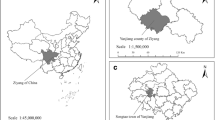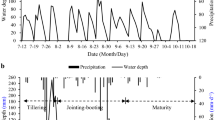Abstract
To assess P losses to surface water by runoff during the rice season and by drainage flow during the winter wheat season, serial field trials were conducted in different types of paddy soils in the Tai Lake Region (TLR) during 2000 and 2001. Four P application rates were set as 0 (CK), 30, 150, and 300 kg P/hm2 for flooded rice trials and 0 (CK), 20, 80, 160 kg P/hm2 for winter wheat trials respectively. Field experiments were done in two locations with a plot size of 30 m2 and four replications in a randomized complete block design. A simplified lysimeter was installed for each plot to collect all the runoff or drainage flow from each event. Total P (TP) losses to surface water during rice season by runoff flow from four treatments were 150 (CK), 220 (T30), 395 (T150), 670 (T300) g P/hm2 in year 2000, and 298, 440, 1828, 3744 g P/hm2 in year 2001 respectively in Wuxi station, here the soil is permeable paddy soil derived from loam clay deposit. While the losses were 102, 140, 210, 270 in year 2000, and 128, 165, 359, 589 g P/hm2 in year 2001 respectively in Changshu station, here the soil is waterlogged paddy soil derived from silt loam deposit. During the winter wheat season, total P lost from the fields by drainage flow in the four treatments were 253 (CK), 382 (T20), 580 (T89), 818 (T160) g P/hm2 in year 2000–2001, and 573.3, 709.4, 1123.2, 1552.4 g P/hm2 in year 2001–2002 at the Wuxi station. While these were 395.6, 539.1, 1356.8, 1972.1 g P/hm2 in year 2000–2001, and 811.5, 1184.6, 3001.2, 5333.1 g P/hm2 in year 2001–2002 at the Changshu station. Results revealed that P fertilizer application rates significantly affected the TP concentrations and TP loads in runoff during the rice season, and by drainage flow during the winter wheat season. Both TP loads were significantly increased as the P application rate increases. The data indicate that TP losses to surface water were much higher during the winter wheat season than during the rice season in two tested sites. The data also reveal that the annual precipitation and evaporation rate affected the soil P losses to surface water significantly. Year 2000 was relatively dried with higher evaporation thus P losses to water by both runoff and drainage flow were less than in year 2001 which was a relatively wet year with lower evaporation. Results indicate that texture, structure of the soil profile, and field construction (with or without ridge and deep drains) affected soil P losses to surface water dramatically. Annual possible TP lost to water at the application rate of 50 kg P/hm2 year tested in TLR were estimated from 97 to 185 tones P from permeable paddy soils and 109–218 tones P from waterlogged paddy soils. There was no significant difference of TP lost between the CK and the T50 treatments in both stations, which indicate that there is no more TP lost in field of normal P fertilizer application rate than in control field of no P fertilized. Much higher TP lost in runoff or drainage flow from those other P application rates treatments than from the T50 treatment, which suggest that P losses to surface water would be greatly increasing in the time when higher available P accumulation in plough layer soil in this region.
Similar content being viewed by others
References
Breeuwsma A, Schoumans OF. 1997 Occurrence and effects of phosphate saturated soils. In Tunney, H. et al., eds. Phosphorus Loss From Soil to Water. Wallingford: CAB International; 438–440.
Catt JA, et al. 1998 Phosphorus losses from arable land in England. Soil Use Manag 14, 168–174.
Cox FR, Hendricks SE. 2000 Soil test phosphorus and clay content effects on runoff water quality. J Environ Qual 29(5), 1582–1586.
Daniel TC. et al. 1994 Minimizing surface water eutrophication from agriculture by phosphorus management. J Soil Wat Conserv Supplement 49(2), 30–38.
Edwards AC, Withers P.J.A. 1998 Soil phosphorus management and water quality: a UK perspective. Soil Use Manage 14, 124–130.
Foy RH, Dils R. 1998 Practical and innovative measures for the control of agricultural phosphorus losses to water. An OECD workshop paper abstract and post papers, Greenmount College of Agriculture and Horticulture, Northern Ireland, June, pp. 16–19.
Hansen NC. et al. 2000 Snowmelt runoff, sediment, and phosphorus losses under three different tillage systems. Soil Tillage Res 57, 93–100.
Heckrath G. et al. 1995 Phosphorus leaching from soils containing different phosphorus concentrations in the Broadbalk experiment. J Environ Qual 24, 904–910.
Hughes S. et al. 2000 Simple phosphorus saturation index of dissolved P in runoff from arable soils. Soil Use Manage 16, 206–210.
Jordan C. et al. 2000 Increased predicted losses of phosphorus to surface water from soils with high Olsen—P concentration. Soil Use Manage 16, 27–35.
Lagreid M. et al. 1999 Agriculture, Fertilizers and Environment [M], Norway: CABI publishing, Norsk Hydro ASA Porsgrunn, pp. 122–157, 174-180.
Lievine SL, Schindler DW. 1998 Phosphorus, nitrogen and carbon dynamics of experimental Lake 303 during recovery from eutrophication, Can J Fishe Aquat Sci. 46, 2–10.
Lu Rukun. 1998 Principal of Soil Plant Nutrition and Fertilization, Beijing: Chemical Industry Press, pp. 433–443 (in Chinese).
Lu et al. 1998.
Murphy J, Riley JR. 1962 A modified single solution method for the determination of phosphate in natural waters. Analyti Chem Acta 27, 31–36.
Olsen SR, Sommers LE. 1982 Phosphorus. In Page, AL et al. eds, Methods of Soil Analysis, Part 2, 2nd edn., Agron. Monogr. 9. ASA and SSSA, Madison, WI, pp. 403–429.
Rohlich GA, O'Connor DJ. 1980 Phosphorus management for the Great Lakes. Final Rep., Phosphorus Management Strategies Task Force, Int. Joint Commission (UC): Pollution from Land Use Activities. Reference Group Tech. Rep. Phosphorus Manage. Windsor, Ontario.
Sharpley AN. et al. 1994 Managing agricultural phosphorus for protection of surface waters: issues and Options. Journal of Environment Quality 23, 37–451.
Sharpley AN. et al. 1993 Phosphorus movement in the landscape. J Product Agricul 6: 492–500.
Sharpley AN. et al. 1999 Agricultural Phosphorus and Eutrophication. USDA, ARS, p. 149.
Simard RR. et al. 1995 Phosphorus status of forest and agricultural soils from a watershed of high animal density. J Environ Quali 24: 1010–1017.
Xu Q. et al. 1980 The paddy soils in the Taihu Lake Region in China. China: Shanghai Science and Technology Press (in Chinese).
Author information
Authors and Affiliations
Rights and permissions
About this article
Cite this article
Cao, Z., Zhang, H. Phosphorus Losses to Water from Lowland Rice Fields under Rice–Wheat Double Cropping System in the Tai Lake Region. Environmental Geochemistry and Health 26, 229–236 (2004). https://doi.org/10.1023/B:EGAH.0000039585.24651.f8
Issue Date:
DOI: https://doi.org/10.1023/B:EGAH.0000039585.24651.f8




